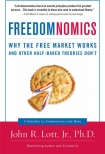Freedomnomics: Why the Free Market Works and Other Half-Baked Theories Don't John Jr. (the dot read aloud .txt) 📖

- Author: John Jr.
Book online «Freedomnomics: Why the Free Market Works and Other Half-Baked Theories Don't John Jr. (the dot read aloud .txt) 📖». Author John Jr.
119 John R. Lott, Jr. and Russell Roberts, “Why Comply: The One-Sided Enforcement of Price Controls and Victimless Crime Laws,” Journal of Legal Studies, vol. 18, no. 2 (June 1989): 403-414.
120 John R. Lott, Jr. and Russell Roberts, “The Expected Penalty for Committing a Crime: An Analysis of Minimum Wage Violations,” Journal of Human Resources, vol. 30, no. 2, Spring 1995: 397-408.
121 Rich Schleif, “Project ChildSafe Begins Second Phase of Nationwide Firearm Safety Tour,” Project ChildSafe, September 1, 2004 (http://www.projectchildsafe.org/news/092004.cfm).
122 John R. Lott, Jr., “A False Safety,” Washington Times, July 6, 2006.
123 Public Health News Center, “Gun Laws Requiring Safe Storage Prevent Some Youth Suicides,” Johns Hopkins Bloomberg School of Public Health, August 3, 2004.
124 Sam Peltzman, “The Effects of Automobile Safety Regulation,” Journal of Political Economy, August 1975; W. Kip Viscusi, “The Lulling Effect: The Impact of Child-Resistant Packaging on Aspirin and Analgestic Ingestion,” American Economic Review, May 1984; and John R. Lott, Jr. and John Whitley, “Safe Storage Gun Laws: Accidental Deaths, Suicides, and Crime,” Journal of Law and Economics, vol. 44, no. 2, part 2, October 2001, 659-689.
125 John A. C. Conybeare, “Evaluation of automobile safety regulations,” Policy Sciences, June, 1980, 27-39. While they did not examine pedestrian deaths, other research has found that “improved automobile safety results in more accidents but fewer total injuries both in NASCAR and on the street.” Russell S. Sobel and Todd M. Nesbit, “Automobile Safety Regulation and the Incentive to Drive Recklessly: Evidence from NASCAR,” Southern Economic Journal, forthcoming (accepted August 2006). This idea was discovered by Sam Peltzman, “The Effects of Automobile Safety Regulation,” Journal of Political Economy, 1975, 677-725. Peltzman’s research found no net change in the number of deaths.
126 W. Kip Viscusi, “The Lulling Effect.”
127 Paula Spencer, “We Protect Kids from Everything But Fear,” Newsweek, April 2, 2007. Http://www.msn.com/id/17770831/site/newsweek/.
128 See the National Center for Injury Prevention and Control (http://webappa.cdc.gov/sasweb/ncipc/mortrate10_sy.html).
129 Ibid.
130 Ibid.
131 John R. Lott, Jr., The Bias Against Guns, Chapter 7.
132 Ibid.
133 Ibid.
134 Ibid.
135 Ibid. See also John R. Lott, Jr. and John Whitley, “Safe Storage Gun Laws: Accidental Deaths, Suicides, and Crime,” Journal of Law and Economics, vol. 44, no. 2, part 2, (October 2001): 659-689. Webster et al. find evidence of a change in suicides for 14- to 17-year-olds. My work in my book and with Whitley examined those under age 15 and those between ages 15 and 19. While there were a few regression estimates that found some drop in suicides for 15- to 19-year-olds, the effects for most regressions did not show statistically significant effects. Daniel W. Webster, Jon S. Vernick, April M. Zeoli, and Jennifer A. Manganello, “Association Between Youth-Focused Firearm Laws and Youth Suicides,” Journal of the American Medical Association , August 4, 2004.
136 For the period from 1977 to 1998 see John R. Lott, Jr., The Bias Against Guns, 170-171. For earlier research for the period from 1977 to 1996 see John R. Lott, Jr. and John Whitley, “Safe Storage Gun Laws: Accidental Deaths, Suicides, and Crime,” Journal of Law and Economics, vol. 44, no. 2, part 2, (October 2001): 682.
Chapter Five: Voting Rights and Voting Wrongs
1 The most notable exception to this rule is Chile during the Pinoche regime. Some might also include Singapore or even modern day China.
2 The gender gap was 14 points in 1980, 16 in 1984, 15 in 1988, 5 in 1992, 17 in 1996, 22 in 2000, and 14 in 2004.
3 Republicans still would have lost the 1992 election, in which Bill Clinton received 41 percent of the men’s vote compared to 38 percent for George H. W. Bush. See Karlyn H. Bowman, “Election Results from A to Z,” AEI Online, January 1, 2001 (http://www.aei.org/publications/pubID.12234/pub_detail.asp); Ruy Teixeira, “A Tour of the 2004 Exit Poll,”The Century Foundation, November 9, 2004 (http://www.tcf.org/list.asp?type=NC&pubid=767); and Gary Langer, “The Gender Gap Makes a Difference,” ABCNews.com, November 8, 1996.
4 For more examples of issues with evident gender gaps, see the 1996 Voter News Service General Election Exit Poll Survey ( http://www.icpsr.umich.edu/cgi-bin/bob/archive2?study=6989&path=ICPSR&docsonly=yes).
5 Kingsley Browne, “Sex and Temperament in Modern Society: A Darwinian View of the Glass Ceiling and the Gender Gap,” Arizona Law Review, 1995, 980.
6 Wyoming and Utah were ahead of their time internationally. Outside the United States, women’s suffrage was first gained in New Zealand in 1893 and in various Australian states beginning in 1895. In those Australian states, as in the U.S., women were first given the vote in somewhat out-of-the-way places where relatively few women lived. By granting women’s suffrage, these states hoped to attract more women to settle the areas. Additionally, women’s suffrage was not viewed as much of a threat, since the small number of women living there meant that their vote initially did not have much of an impact on election outcomes. In 1869, Britain began allowing some women to vote strictly in local elections. Sweden had also granted limited women’s suffrage for some local elections in 1862-63. By contrast, Wyoming and Utah granted suffrage to all women for all elections. (http://womenshistory.about.com/od/suffrage/a/intl_timeline.htm).
7 Unfortunately, no data exists on voting by men and women separately.
8 To the extent that voting by women reduces the return to men of voting, the simple increase in the percent of the population voting underestimates the number of women who vote.
9 Because state expenditures and revenues were missing for some years, the changes in the average state’s values between years were calculated for those states





Comments (0)